Microgreens and Nutrition: Tiny Greens, Big Benefits
In the vibrant culinary world of the United States, a superfood has been growing in popularity since the 1980s – microgreens. These small, nutrient-rich greens have won over health enthusiasts, chefs, and gardeners. They offer big benefits despite their small size.
Microgreens are young, tender plants harvested between 7 to 21 days after germination. They are packed with vitamins, minerals, and antioxidants, often up to 40 times more than mature plants. This makes them a great choice for many dishes, from salads and sandwiches to smoothies and garnishes.
Microgreens are not just tasty; they’re also good for you. They can help lower bad cholesterol and triglycerides, support heart health, and may reduce the risk of cancer and heart disease. Plus, they are safe to eat, making them easy to add to any diet.
Key Takeaways
- Microgreens are packed with nutrients, often containing up to 40 times more vitamins, minerals, and antioxidants than mature greens.
- Incorporating microgreens into your diet can provide a range of health benefits, including improved heart health, reduced inflammation, and enhanced immune function.
- Growing your own microgreens at home is a cost-effective and convenient way to enjoy these nutrient-dense greens.
- Microgreens can be easily incorporated into a variety of dishes, from salads and sandwiches to smoothies and warm dishes.
- Amaranth microgreens, in particular, are a nutrient-dense variety that offer a wealth of essential vitamins, minerals, and beneficial plant compounds.
What are Microgreens?
Microgreens are young, tender greens harvested 10-14 days after germination. They have their first true leaves. These tiny veggies are packed with flavor and nutrition, measuring just 1-3 inches tall.
Definition and Characteristics
Microgreens are not like sprouts or baby greens. Sprouts have only the seed and stem, while microgreens have both stem and leaves. Baby greens are larger and more mature than microgreens. Microgreens come in many colors, flavors, and textures, making them versatile in cooking.
Different from Sprouts and Baby Greens
- Microgreens have both the stem and leaves, unlike sprouts which only have the seed and stem.
- Microgreens are typically harvested 10-14 days after germination, while baby greens are more mature and larger in size.
- Microgreens offer a diverse range of flavors, colors, and textures, adding visual appeal and unique taste profiles to dishes.
Microgreens are a unique and nutrient-dense addition to any diet. They provide a flavorful and visually appealing way to add more veggies to your meals. Knowing how microgreens differ from sprouts and baby greens helps you use them to their fullest potential.
Types of Microgreens
Popular Varieties and Plant Families
Microgreens come from many plants, offering a variety of tastes, textures, and nutrients. They are part of different plant families. For example, the Brassicaceae family includes broccoli, cabbage, and radish. The Asteraceae family has lettuce, endive, and chicory.
According to a study by Kyriacou et al. (2019), 13 microgreens showed different nutritional and chemical profiles. This means you can pick from many flavors and nutrients to match your taste.
Popular microgreens include broccoli, kale, red cabbage, cilantro, garnet amaranth, and green daikon radish. They are packed with sulforaphane, vitamins, and minerals. Adding them to salads, soups, and sandwiches makes meals more nutritious and tasty.
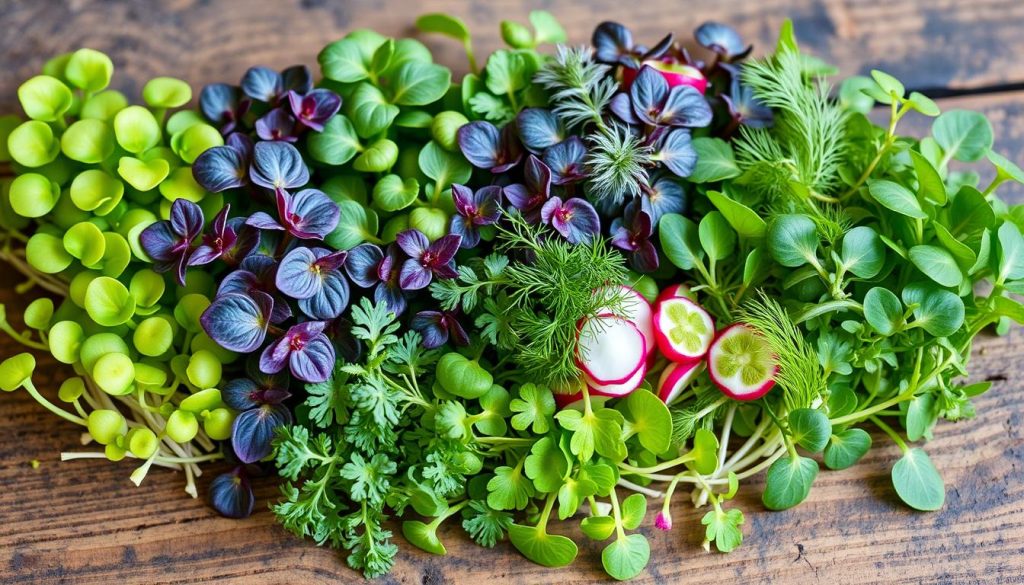
Microgreens are not just for eating. A report by Treadwell et al. (2020) from the University of Florida sees them as a new crop with big market potential. They meet the demand for healthy and good-looking food.
Nutritional Powerhouses
Microgreens are packed with nutrients, often having vitamins, minerals, and antioxidants more than mature greens. Studies show they can have up to 40 times more nutrients than their full-grown versions. This is because the young leaves and stems of microgreens are rich in nutrients.
Some microgreens, like red cabbage, broccoli, and radish, are full of antioxidants. Others, such as arugula and mustard greens, are high in dietary fiber, which is good for your digestion. They also offer a lot of vitamins C, E, and K, beta-carotene, lutein, and zeaxanthin. This makes them a great choice for any meal.
Nutrient Density Compared to Mature Greens
- Microgreens often have more nutrients than their mature versions.
- Red cabbage microgreens have up to six times the vitamin C of mature red cabbage.
- Garnet amaranth microgreens have a lot of vitamin K, vitamin E, and other nutrients.
- Vitamin C is found in broccoli, radish, and mustard microgreens.
- Amaranth and basil microgreens are full of Vitamin K.
- Lentil and chickpea microgreens are great for iron.
- Fenugreek and arugula microgreens give you a good amount of calcium.
- Antioxidants like polyphenols, flavonoids, and carotenoids are in clover, daikon radish, and sunflower microgreens.
Microgreens add flavor and color to any meal, making them a great choice for health-conscious eaters.
Health Benefits of Microgreens
Heart Health and Chronic Disease Prevention
Eating microgreens can boost your heart health and lower the risk of chronic diseases. These small greens are full of antioxidants and plant compounds. They can greatly improve your overall health.
Research shows that microgreens’ antioxidants, like polyphenols, can lower cholesterol and reduce inflammation. This helps keep your heart healthy and lowers the risk of heart disease. They also help prevent diabetes, Alzheimer’s, and some cancers.
- Microgreens are rich in vitamins C, E, and carotenoids, which are good for you.
- They are full of minerals like potassium, iron, zinc, magnesium, and copper.
- Polyphenols, a type of antioxidant, are found in many microgreens, with some having 164 types.
- Carotenoids, another antioxidant type, are much more common in microgreens than in adult leaves.
Microgreens are full of antioxidants and nutrients, making them great for a healthy diet. Adding them to your meals can support your health and lower the risk of chronic diseases.
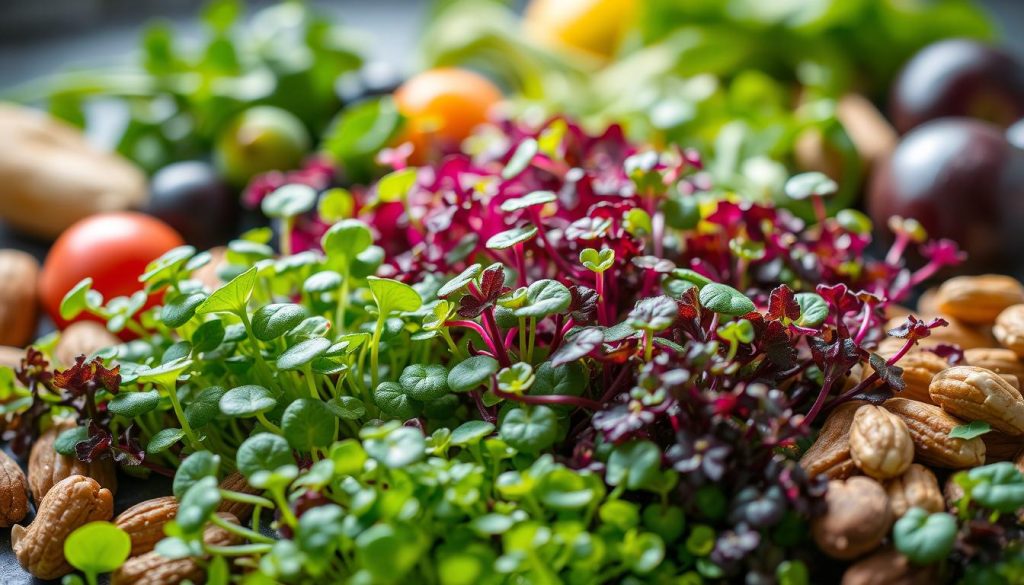
“Microgreens are a nutritional powerhouse, packed with essential vitamins, minerals, and antioxidants that can benefit your heart health and help prevent chronic diseases.”
Safety Considerations
Microgreens are usually safe and nutritious. But, there are some important things to remember. The warm and humid conditions for growing microgreens can lead to harmful bacteria. This includes Salmonella and E. coli if the growing medium or seeds are dirty.
To avoid this, use high-quality seeds from trusted sources and clean, sterile growing medium. A survey of about 50 microgreen growers showed that keeping food safe is a big concern. This is because of recalls due to Salmonella contamination.
A study by the American Chemical Society found that microgreens have a lot more nutrients than regular greens. They have more Vitamin C, E, K, and beta-carotene. This means we need to handle and store them safely to keep them safe to eat.
Microgreens should be kept cold, between 32°F and 41°F, as the FDA says. They should be eaten within 10-12 days of picking. Also, they’re not washed by producers to prevent mold, so we must wash them before eating.
By following these safety tips and using clean growing conditions, microgreens can be a safe and healthy choice. Knowing about food safety is key to trusting and enjoying these greens.
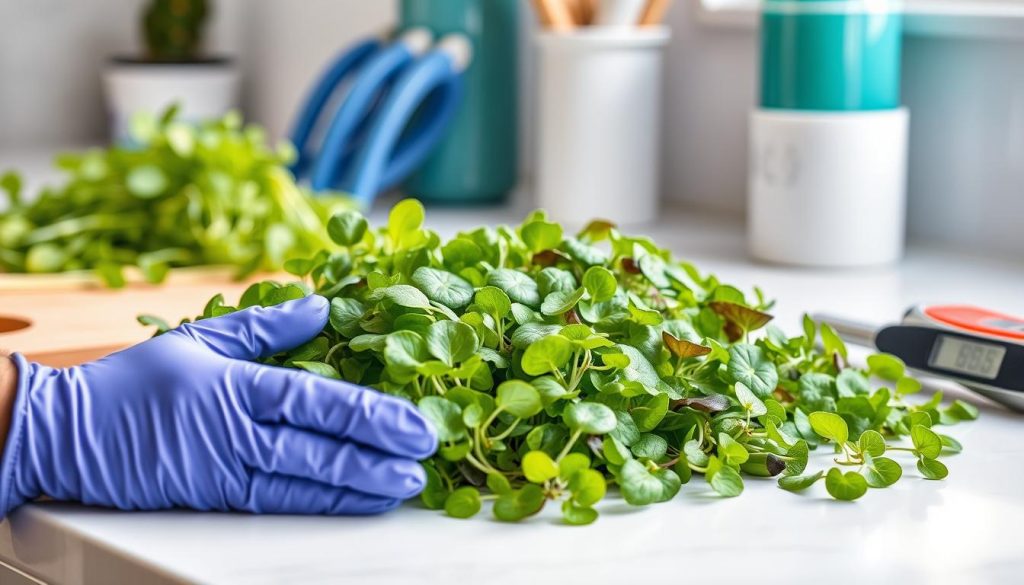
Incorporating Microgreens into Your Diet
Microgreens are easy to add to many dishes for a nutritional boost and great taste. They’re perfect for salads, sandwiches, and wraps. You can also blend them into smoothies or juices. Plus, they make a tasty garnish for soups, omelets, pizzas, and more. These greens offer endless ways to stay healthy and enjoy your food.
Creative Ways to Use Microgreens
- Toss microgreens into your favorite salad for an extra crunch and nutrient punch.
- Add microgreens to sandwiches, wraps, and burgers for a fresh, crisp texture.
- Blend microgreens into smoothies or juices for a nutrient-dense beverage.
- Use microgreens as a garnish on soups, omelets, and other hot dishes to add color and flavor.
- Sprinkle microgreens on top of pizza, pasta, or rice dishes for a flavorful finishing touch.
- Incorporate microgreens into stir-fries, sautés, or as a topping for grain bowls.
Microgreens can be used in many ways in your diet. They bring vibrant colors, soft textures, and lots of nutrients to your meals. These tiny greens can make any dish better and are good for your health.
| Dish | How to Use Microgreens |
|---|---|
| Salads | Toss microgreens into your favorite salad for an extra crunch and nutritional boost. |
| Sandwiches and Wraps | Add microgreens to sandwiches and wraps for a fresh, crisp texture. |
| Smoothies and Juices | Blend microgreens into your favorite smoothie or juice for a nutrient-dense beverage. |
| Soups, Omelets, and Hot Dishes | Use microgreens as a garnish on soups, omelets, and other hot dishes to add color and flavor. |
| Pizza, Pasta, and Rice Dishes | Sprinkle microgreens on top of pizza, pasta, or rice dishes for a flavorful finishing touch. |
| Stir-Fries, Sautés, and Grain Bowls | Incorporate microgreens into stir-fries, sautés, or as a topping for grain bowls. |
By adding microgreens to your meals, you get lots of health benefits. They make your food taste great and are good for you.
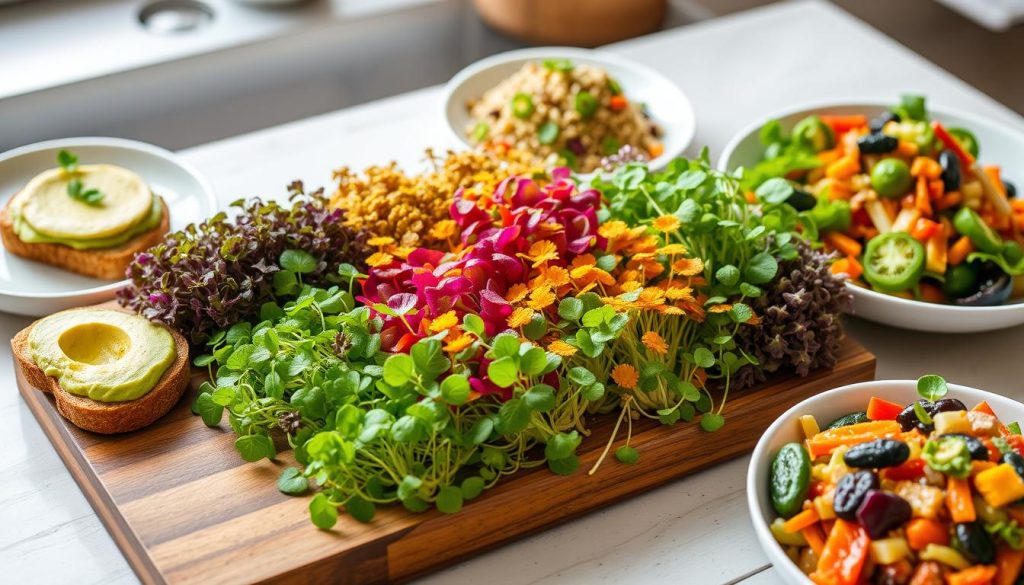
Growing Your Own Microgreens
Growing your own microgreens at home is rewarding and saves money. It’s easy and needs little equipment, making it great for beginners and pros alike. With a simple guide, you can grow many microgreens in your space, like a sunny windowsill or a small garden.
Step-by-Step Guide to Growing Microgreens
- Choose Your Microgreen Variety: Pick the microgreen seeds you want, thinking about what you like, how fast they grow, and their nutrients. Popular choices include broccoli, radish, kale, and sunflower microgreens.
- Prepare the Growing Medium: Fill a shallow tray with a good potting mix or a special microgreen medium. Make sure it’s damp but not too wet.
- Sow the Seeds: Spread the microgreen seeds evenly over the medium. Press them gently into the soil. Cover them with a thin layer of vermiculite or more medium.
- Provide Adequate Lighting: Microgreens need lots of sunlight or artificial light. Put your tray in a sunny spot or under a grow light. They should get 12-16 hours of light daily.
- Maintain Consistent Moisture: Keep the soil moist by misting it often with water. Don’t let it dry out, or your microgreens will grow poorly.
- Harvest at the Optimal Time: Harvest your microgreens in 7-21 days, depending on the type. Cut them just above the soil with clean scissors or a knife, leaving the roots behind.
- Store and Enjoy: Keep your fresh microgreens in the fridge with a damp paper towel to keep them fresh. Add them to your meals, salads, and snacks for a tasty and healthy boost.
Growing your own microgreens is rewarding and easy. With a simple guide, you can grow many types in your space. This ensures you always have these nutrient-rich greens on hand.
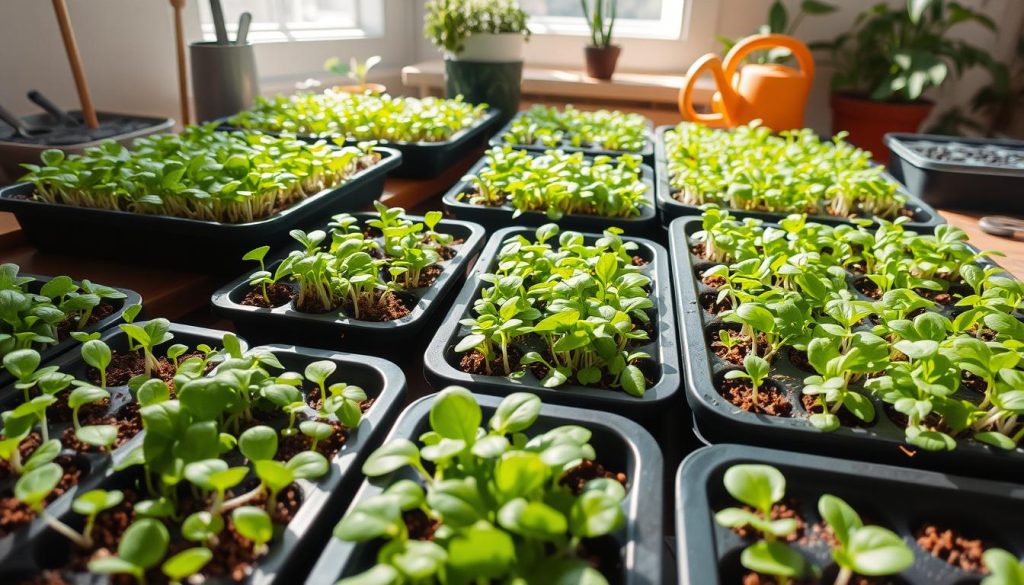
Amaranth Microgreens: A Nutrient-Dense Variety
Amaranth microgreens come from the Amaranthus plant family. They have a long history, dating back over 5,000 years. The Incas, Mayans, and Aztecs in South America used to eat them a lot. These microgreens are harvested 10-14 days after germination. They are full of nutrition in a small package.
What are Amaranth Microgreens?
Amaranth microgreens are the young leaves and stems of the Amaranthus plant. They grow fast and have bright colors. They are loved by health lovers and food fans for their great taste and health benefits.
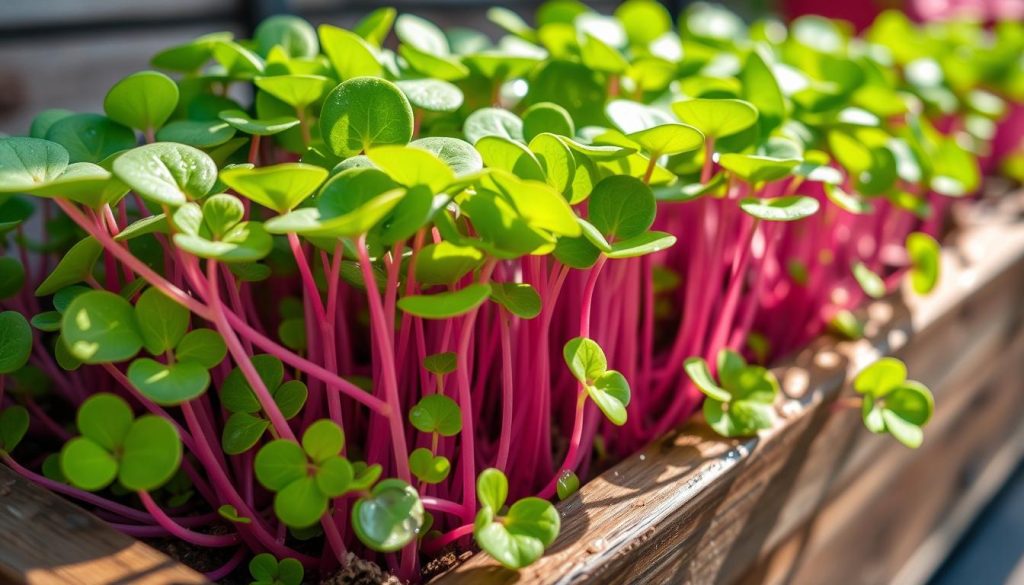
To grow amaranth microgreens, plant about 38 seeds per square inch. There are 1,300 to 1,350 seeds in a gram of Red Garnet Amaranth seeds. Spread the seeds evenly on the soil in a tray, holding about 1,350 seeds in just a quarter of a teaspoon.
The red color of amaranth microgreens gets even brighter with more light. This makes them look great and be more nutritious.
| Nutrient | Amount per 100g |
|---|---|
| Energy | 23 Kcal |
| Carbohydrates | 4.02g |
| Protein | 2.46g |
| Dietary Fiber | 2.2g |
| Vitamin K | 1140μg |
| Vitamin C | 43.3mg |
| Iron | 2.32mg |
| Calcium | 215mg |
Amaranth microgreens are not just pretty; they’re also super nutritious. They’re full of vitamins, minerals, and antioxidants. These tiny greens have lots of vitamin K, fiber, and protein, making them a great addition to your diet.
Nutritional Profile of Amaranth Microgreens
Amaranth microgreens are a nutritional powerhouse. They have a lot of essential vitamins, minerals, and antioxidants. These greens have up to 40 times more nutrients than their mature versions.
They are full of vitamin K, important for blood clotting, and vitamin C, which helps the immune system. They also have a lot of iron, which is key for making red blood cells.
| Nutrient | Amount per 100g |
|---|---|
| Vitamin K | 369 μg |
| Vitamin C | 80 mg |
| Iron | 3.9 mg |
| Protein | 4.4 g |
| Fiber | 3.7 g |
| Carbohydrates | 8.1 g |
Amaranth microgreens also have antioxidants and phytochemicals. These can help lower the risk of chronic diseases.
“Microgreens, on average, have about five times greater levels of vitamins than their mature plant counterparts.”
With their amazing nutrients, amaranth microgreens are seen as a superfood. Adding them to your diet is a great way to get more nutrients. It supports your health and wellbeing.
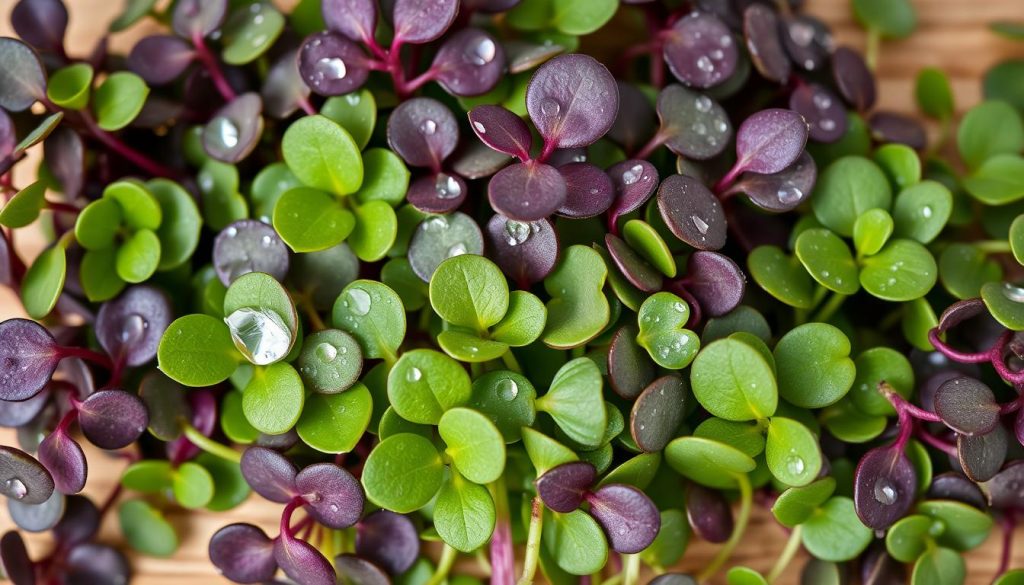
Health Benefits of Amaranth Microgreens
Eating amaranth microgreens brings many health perks. These small greens are full of nutrients that help our health in many ways.
Boosting Immune Function
Vitamin C in amaranth microgreens boosts the immune system. It helps fight off diseases and infections. This vitamin is key for making white blood cells, which protect us from germs.
Promoting Bone Health
Vitamin K in these greens is great for bones. It helps bones stay strong and may prevent osteoporosis. This vitamin makes sure bones use calcium well.
Aiding Digestion
Fiber in amaranth microgreens keeps digestion healthy. It helps with bowel movements and keeps the gut balanced. This can ease constipation, bloating, and IBS.
Reducing Inflammation
Amaranth microgreens have antioxidants and anti-inflammatory stuff. These can lower the risk of heart disease, Alzheimer’s, and some cancers. They fight off bad free radicals and reduce inflammation.
Boosting Energy and Weight Management
These greens are full of protein and nutrients, which boost energy and metabolism. The protein keeps muscles strong. Fiber and other nutrients help with feeling full and losing weight.
Supporting Healthy Pregnancy
They’re packed with folate, important for pregnant women. Folate prevents neural tube defects and helps the baby grow healthy. Adding these greens to the diet is good for pregnant women.
Amaranth microgreens are amazing for health. They help with immunity, bone health, digestion, and inflammation. These tiny greens are a great addition to any diet.
Incorporating Amaranth Microgreens into Your Diet
Amaranth microgreens are a versatile ingredient that can be easily added to many dishes. They bring a nutritional boost and unique flavor. These tiny greens are full of vitamins, minerals, and phytochemicals.
One easy way to enjoy amaranth microgreens is by topping your salads. Their crunchy texture and earthy taste add flavor and nutrition. They also work well in sandwiches, wraps, and as a garnish for soups and omelets.
For a nutrient-dense smoothie or juice, blend amaranth microgreens with fruits and vegetables. The vibrant green color and mild flavor mix well with many ingredients. This creates a nutrient-packed drink that’s great any time of day.
| Nutrient | Amount per Serving |
|---|---|
| Energy | 23 kcal |
| Protein | 2.46g |
| Total Fat | 0.33g |
| Dietary Fiber | 2.2g |
| Calcium | 215mg |
| Iron | 2.32mg |
| Zinc | 0.9mg |
| Vitamin K | 1140 μg |
| Vitamin C | 43.3mg |
| Vitamin A | 2917 IU |
Adding amaranth microgreens to your diet has many health benefits. It supports heart health, promotes digestion, and boosts energy. Try different ways to enjoy these nutritional powerhouses and enjoy their exceptional nutrient density.
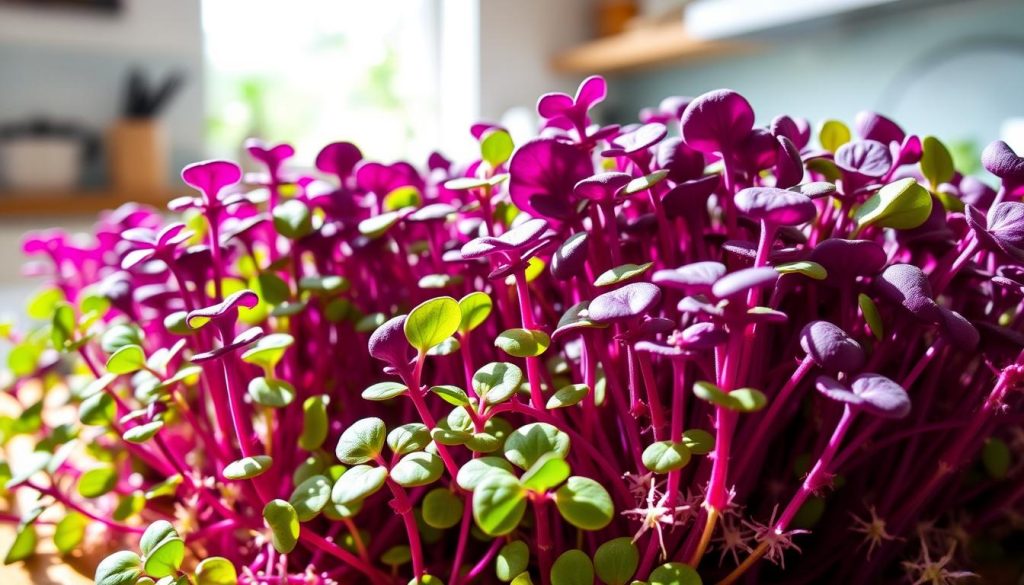
Gardening Tools for Microgreen Cultivation
Growing microgreens at home is easy with the right supplies and tools. You’ll need a growing tray, good soil or a special mix, and either natural or artificial light. These are the basics for growing healthy, tasty microgreens in your kitchen or backyard.
Essential Supplies and Equipment
- Growing Trays: Shallow, 10×20-inch trays are perfect for microgreens. They give the plants enough room to grow.
- Growing Medium: You can use potting soil, coco coir, or a mix made just for microgreens. This helps with air and water flow.
- Lighting: LED grow lights are key for indoor gardens without sunlight. They make sure the plants get enough light to grow well.
- Spray Bottles: Fine mist spray bottles keep the right humidity during germination and growth.
- Humidity Domes: Domes or plastic wraps create a warm, moist space for fast, even germination.
- Hydroponics Systems: Indoor growers might prefer hydroponics for a soil-free, nutrient-rich way to grow microgreens.
- Harvesting Tools: Special scissors or sharp kitchen shears make it easy to harvest microgreens without damaging them.
With the right tools and supplies, growing microgreens can be a success. A bit of planning and care lets you enjoy these tasty greens from home.
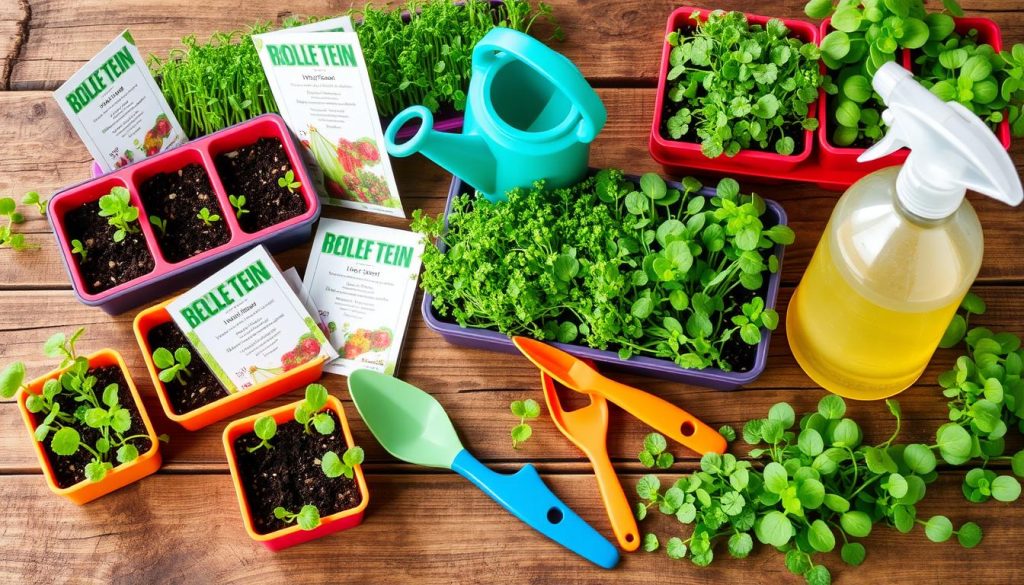
Online Resources for Microgreen Growers
For those interested in growing their own microgreens, many online resources are available. These tools can help you start and learn more. They are great for both beginners and those who already love microgreens.
Home Microgreens is a great place to start. It offers a free 12-video course on growing microgreens. The site has over 175 articles on topics like the best microgreens to grow and their health benefits.
Home Microgreens also sells products like potting soil and microgreen seeds. Prices range from $1.49 to $29.99. The podcast talks about best practices and new varieties to try.
Online courses offer a deeper learning experience. They teach everything from seed selection to harvesting. This helps you grow a successful microgreen garden.
Online communities are great for support and inspiration. Growers share their experiences and recipes. It’s a place to connect with others and learn new things.
Whether you’re new to microgreens or want to improve, online resources can change the game. They offer guides, video lessons, courses, and communities. These tools help you make the most of growing microgreens.
microgreens and nutritions
Microgreens are known for being nutritional powerhouses. They offer a lot of vitamins, minerals, and antioxidants. In fact, they can have up to 40 times more nutrients than regular greens.
These tiny greens are harvested in just a couple of weeks. This makes them very nutrient-dense. For example, kale and broccoli as microgreens have more beneficial compounds than when they are fully grown.
Because of their high nutrient levels, microgreens have many health benefits. They can help prevent weight gain, improve gut health, and fight malnutrition in older adults.
The abundance of antioxidants in microgreens is impressive. They can support heart health and lower the risk of chronic diseases. For instance, broccoli microgreens are full of sulforaphane. This can help lower blood sugar levels and protect against heart disease and cancer.
| Microgreen Variety | Nutrient Comparison to Mature Vegetable |
|---|---|
| Red Cabbage Microgreens | 3 times more folate than mature red cabbage |
| Arugula Microgreens | 100% more vitamin A than mature arugula |
| Radish Microgreens | Richer in calcium and omega-3s compared to mature radishes |
Microgreens are becoming popular because of their nutritional benefits and taste. They are great for boosting your vitamin intake, supporting heart health, or adding flavor to your meals. Adding microgreens to your diet can really change the game.
Conclusion
Microgreens are a great way to add nutrition to your meals. They are full of vitamins, minerals, and plant compounds. This makes them a powerful choice for health.
Adding microgreens to your meals can help your heart, reduce inflammation, and boost your immune system. They are easy to get, whether you buy them or grow them yourself.
These nutrient-dense greens are packed with color, flavor, and texture. They make any dish look and taste better. This makes them a key part of a healthy diet.
For those who want to grow microgreens, it’s easy and can be done at home, even with little space. Adding microgreens to your meals is a great way to improve your health. Enjoy the taste and benefits of these greens every day.